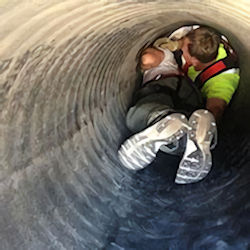Confined Space Emergencies
A confined space emergency is any occurrence inside or outside the space, including failure of hazard control or monitoring equipment, that may endanger authorized confined space entrants.
Believe it or not, during emergencies, rescuers end up as confined space fatalities more often than those being rescued. So, why is that? Fatalities can occur when the rescuers:
- are overcome by their emotions
- take unnecessary chances
- do not know the hazards involved
- do not have a plan of action
- lack confined space rescue training
It is important to know that the period of time for successful rescue is very limited. Otherwise, a rescue attempt will become body retrieval. After only four minutes without oxygen, it is very likely that a worker will experience asphyxiation, which may result in brain damage or death.
Preventing Confined Space Rescuer Fatalities
Planning the rescue is paramount. Make sure rescue team members understand their duties, and practice, practice, practice!
Ensure that the rescuer does not travel a greater distance than allowed by the air supply, self-contained breathing apparatus (SCBA), and escape cylinders. Analyze distance, space configurations, physical obstacles, and total time needed to enter the space, perform rescue operations, and leave the space. Leave the space immediately whenever a problem arises with respiratory protection equipment or whenever the attendant orders evacuation. Everyone involved in a rescue should assume that the space is deadly and that entry rescue may be required in the worst case!
Knowledge Check Choose the best answer for the question.
8-2. A worker will likely experience asphyxiation from a lack of oxygen after _____.
You forgot to answer the question!

